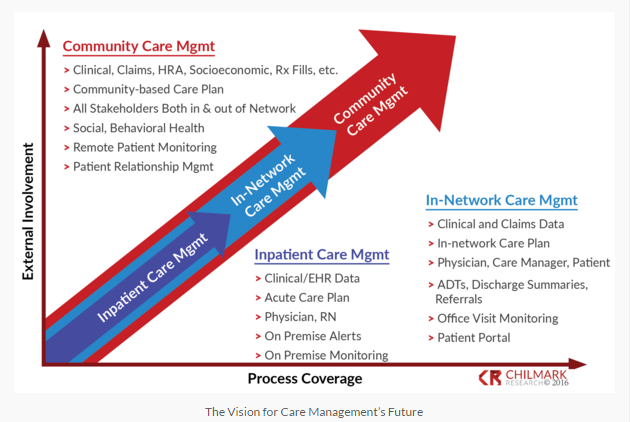Providers Squeezed to Integrate Care Management Solutions
The Affordable Care Act has brought more attention to care management solutions, but has moved the focus away from health payers and led providers to take on more responsibility.

- At this year’s HIMSS conference and exhibition, Chilmark Research released the 2016 Care Management Market Trends report, which outlines how the market is leaning on healthcare providers to create care management solutions. The report also delves into the care management products that are to be promoted at the 2016 HIMSS conference, according to a company press release.

The Patient Protection and Affordable Care Act has brought more attention to care management solutions, but has now moved the focus away from health payers and has led providers to take on more responsibility when it comes to care management. Healthcare organizations are being encouraged to improve episodic care coordination and enhance the treatment and prevention of chronic disease.
Since healthcare organizations are often still working in a fee-for-service environment, it becomes more complex to switch toward value-based care and pay-for-performance models of reimbursement. Despite the fee-for-service environment, many healthcare providers have their revenue tied to meeting specific performance measures.
Sometimes hospitals have reimbursement in the form of a bundled payment system, which brings revenue for an entire episode of care instead of a particular service. Essentially, hospitals and clinics are changing their business practices and investing in care management solutions that improve coordination and “self-management support,” the release explains.
More and more doctors, nurses, clinicians, and other healthcare specialists will focus on working as a team in order to reach the Triple Aim of better health outcomes, increased patient satisfaction, and reduced healthcare spending.
Many health IT vendors have been working with providers to deliver products that streamline care management protocols and support workflows among multiple medical teams. The Chilmark Research report details more than 100 care management products leading to a growth in the market along with the key vendors showing greater expertise in the field.
However, the report also outlines how many of these solutions need to expand and grow in order to move past “core competencies that only address individual stages of the care management lifecycle.” Within the crowded market, vendor products must include risk-stratification and evidence-based care protocols as well as provide a real reason for why a healthcare organization should choose the specific care management solution.
The report details that care management products are still in their infancy, as this is a brand new environment for health IT vendors. There is still no single vendor that can meet the demands of providers integrating care management solutions throughout their organization, the report finds.
“Provider-led care management is really in its infancy,” Matt Guldin, Chilmark analyst and author of the report, said in a public statement. “Today, HCOs are only experimenting with these tools and using them for revenue assurance and utilization management.”
“The next major stage in their evolution will be to help drive better patient care and allow them to successfully scale their care management efforts to support larger numbers of patients. Looking ahead, HCOs [healthcare organizations] will look to incorporate care management across a wider variety of care settings, incorporate additional clinical and non-clinical stakeholders, and directly embed a higher level of automation and workflow processes within these solutions.”
Care management of chronic medical conditions often relates to the older generation and Medicare beneficiaries. During a webinar about the Medicare program, Erica Morgenstern, Vice President of Public Relations & Marketing Communications at Welltok, and Stephen Ewell, Executive Director of the Consumer Technology Association Foundation, spoke about how it is beneficial to connect Medicare beneficiaries, people with disabilities, and older adults to technology in order to improve their health and well-being.
The webinar outlined a survey in which it was found seniors are very dedicated to improving their health and feeling better. It was also discovered that the majority of older adults are tech-savvy and providers could utilize online tools and mobile health technology to boost patient engagement among this population.
“These results confirm that seniors, just like any other age group, want to live healthier and longer, but they are not feeling empowered to do so by the healthcare system,” Michelle Snyder, Chief Marketing Officer for Welltok, said in a public statement. “There is a real opportunity to better understand this population at an individual level and drive real change by connecting them with the right guidance, resources and incentives, in the right way.”
While 92 percent of older adults answered in the survey that they have health goals, more than 80 percent have stated that using technology in their daily life.
“Ways to maintain a better life, feel good with less pain, and maintain independence are big trends that we see throughout the older adult population. This ties into about some of the ways we can help them reach these goals,” Ewell began.
“Whether you’re talking about students trying to get good grades in school or older adults joining orientations like AARP to get discounts, we find that there are certainly financial incentives that can create attention to healthier lifestyles and lead to action for older adults,” he continued.
“We see that 81 percent of survey takers said that technology plays some role in their daily lives. [We can use this data to uncover] ways that technology can help maintain independence and quality of life,” Ewell concluded. “Certainly, there are challenges as far as maintaining knowledge about what technologies are out there and keeping up with the innovations that are continually coming to market.”
“That’s where we’ve really seen a lot of opportunities with organizations across the country… there are organizations that are allowing people to learn different types of technologies and providing that education around the type of technology that can really help maintain healthy and independent lives.”
Image Credits: Chilmark Research

